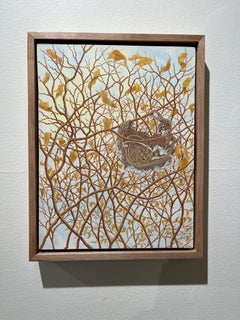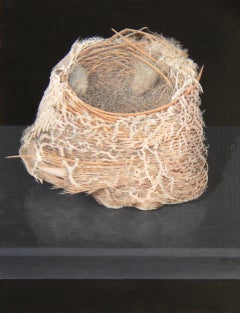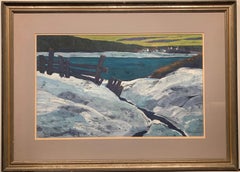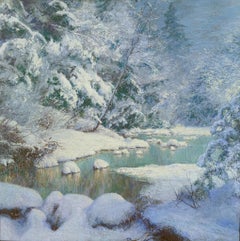Alan Bray Art
American, b. 1946
Alan Bray was born in Waterville, Maine, on January 12, 1946, but he grew up in Monson, a small slate-quarrying town set in the northern reaches of the Appalachians. It was here, hiking and camping with liked-minded childhood friends, that he began to exercise his natural inquisitiveness as a tool for building woods-craft. In these rugged foothills, ever alive with the turning of the seasons yet always plainly bearing the imprint of eons-old geologic upheaval, Bray learned to find his way around in a world of enigmatic signs and divergent trails. Unwittingly, before ever picking up a brush, he developed the sensibilities of a landscape painter by developing sensitivities to the relationships between the living and the ancient land on which life depends.
Later, when Bray decided to study art formally, he enrolled in the Art Institute of Boston, where he first felt the appeal of image-making as a way of understanding the world. Three years of studio work revealed the need for a more traditional approach to the discipline of painting, one informed by the broader range of a liberal education, a revelation that prompted Bray to enroll at the University of Southern Maine, from which he graduated in 1971. While this education was in many ways a success – particularly in the way it engendered literacies in fields outside the fine arts – it was nevertheless incomplete: well-prepared now for the next leg of the journey, Bray traveled to Florence to study at Villa Schifanoia Graduate School of Fine Arts.
Villa Schifanoia, Florence, the Italian Renaissance held many treasures and gave freely to a painter who was now mature enough in his art to receive them. Including a new medium and a new physical structure for his paintings –tempera on panel. The technical challenges of this medium, the necessary adjustments in craft, and the limitations of scale favored, and inspired, someone of a practical as well as a visionary intelligence.
Bray paints in casein, a milk-based tempera that has virtually no drying time. Necessarily, his paintings are technically complex because they consist of thousands of tiny brush strokes, built up in layers, out of which the images – the vision – advance from the foundation of a mirror-smooth, absolute void of white ground. It is a method of painting that follows directly from his method of exploring his subjects.(Biography provided by Garvey|Simon)
to
1
5
5
2
2
1
3
2
Overall Height
to
Overall Width
to
5
3
3
2
2
1
1
1
1
1
1
1
1
1
5
5
6,847
3,161
2,517
1,217
5
5
5
4
Artist: Alan Bray
Alan Bray, Windblown, 2023, impressionist casein nature nest painting
By Alan Bray
Located in New York, NY
The latest painting from Alan Bray is a rare and exotic sighting, indeed. He’s shifted his focus away from the human realm and up to the skies, capturing an empty bird’s nest camoufl...
Category
2010s American Impressionist Alan Bray Art
Materials
Casein, Panel
Alan Bray, Nest in a Nest, 2023, impressionist casein nature nest painting
By Alan Bray
Located in New York, NY
The latest painting from Alan Bray is a rare and exotic sighting, indeed. He’s shifted his focus away from the human realm and up to the skies, capturing an empty bird’s nest camoufl...
Category
2010s American Impressionist Alan Bray Art
Materials
Casein, Panel
Hermit Thrush, impressionist casein nature painting
By Alan Bray
Located in New York, NY
A narrative from the artist:
"It belonged to a Hermit Thrush, which has one of the most beautiful songs in all of nature. Give it a listen on Audubon. A...
Category
2010s American Impressionist Alan Bray Art
Materials
Casein, Panel
Clearing Off, contemporary Impressionist casein landscape painting
By Alan Bray
Located in New York, NY
Alan Bray’s landscape paintings of his native, central Maine explore the ever-ebbing dynamic between nature and humanity. His paintings capture an asymmetrical pas de deux. Painted with uncompromising precision by his quick-drying casein tempera paint, Bray’s trailheads, shorelines, and vast horizons show evidence of previous human presence as it succumbs to natural growth.
Bray’s stylized scenes center on these afterimages of human interference as well as other natural phenomena. Inundated with detail, nature reclaims swaths of scarred land, fallen trees, and dilapidated structures, returning them to their wild form. Natural phenomena such as wild overgrowth, animal tracks, mysterious forms, bogs, and mist are resplendently captured as homage to the rugged and uninhabited corners of secluded Maine.
Alan Bray builds his landscapes with numerous layers of quick-drying casein tempera. Often used in Italian Renaissance painting...
Category
2010s American Impressionist Alan Bray Art
Materials
Casein, Panel
A Rise, blue and green casein on panel impressionist waterscape painting, 2004
By Alan Bray
Located in New York, NY
Bray has explored a smaller, more demure 8.5 x 11 inch format for two of these casein on panel paintings. When coupled with his rich palette and tightly hatched bed of brushstrokes, ...
Category
2010s American Impressionist Alan Bray Art
Materials
Casein
Related Items
Maine Morning
Located in Wilton Manors, FL
Beautiful winter landscape by American artist, J. Philip Richards (1906-1991). Maine Morning, 1974. Casein on paper, 16 x 26 inches; 26 x 36 inches framed. Signed lower right. Signed, titled and dated on verso. Excellent condition.
Born in Moosic, PA, and graduated from the College of Fine Arts of Syracuse University in New York, J Philip Richards worked and studied with such artists of international reputation as William Von Schlagell, James Fitzgerald, David Porter, and John Taylor.He was professor emeritus of Fine Arts at Wilkes College in Wilkes-Barre, PA. Member of the American Watercolor Society, NYC, NY; York Artists Association, York, ME; Ogunquit Art Association, Ogunquit, ME; Wyoming Valley Art League, Wilkes-Barre, PA; National Society of Casein Painters, NYC, NY; Director Ancestor's Art Workshops, Searsport, ME; Gallery Director, "Gallery 164," Kennebunk, ME; Professional Artists League of America, NYC, NY; Art Guild of Kennebunks, Kennebunk, ME; Maine Artists...
Category
1970s Impressionist Alan Bray Art
Materials
Casein
Winter Scene
By Walter Launt Palmer
Located in New York, NY
In this prototypical oil painting, Walter Launt Palmer's title as "the painter of the American winter" can be vividly and brilliantly seen. As an impressionist painter that emerged at the turn of the 20th century, Palmer took great interest in the picturesque American landscape, though he particularly focused on the rendering of this landscape glistening with snow. His pictures evoke an unreplicable natural serenity, and in this oil painting "The Winter Scene...
Category
Early 20th Century American Impressionist Alan Bray Art
Materials
Oil
"Evening View to the South West" , Oil Painting
By David Grossmann
Located in Denver, CO
David Grossman's (US based) "Evening View to the South West" is an original, handmade oil painting that depicts a wide open plain of the West with fields of...
Category
2010s American Impressionist Alan Bray Art
Materials
Linen, Panel, Oil
Cowboy Driving Cattle, Realist Figurative Landscape
Located in Soquel, CA
Dynamic Western figurative landscape scene of a cowboy and cattle, depicted with realist detail as they splash through a river, by unknown artist Jan Watson (American, 20th Century)....
Category
1980s American Impressionist Alan Bray Art
Materials
Oil, Canvas
H 32 in W 44 in D 3 in
Doctor Lake, Wisconsin Landscape, Burnett County
By George Raab
Located in Grand Rapids, MI
George Raab (American, 1866 - 1943)
Signed: G. Raab 1912 (Lower, Right)
" Doctor Lake ", 1912
Oil on Canvas
18" x 22"
Housed in a 3" Period Carved Frame in the style of Newcomb ...
Category
Early 20th Century American Impressionist Alan Bray Art
Materials
Oil, Canvas
Lord of Luckenback, oil painting, Texas Animals, Rooster Painting, Texas Artist
Located in Houston, TX
Lord of Luckenback is an oil painting of a Texas Rooster prancing in the field. It is 20 x 16 and comes with a custom made frame.
Artist State...
Category
2010s American Impressionist Alan Bray Art
Materials
Oil
Breath of Dawn, 1970's Sunrise Lake Landscape
Located in Soquel, CA
Gorgeous watercolor/gouache painting of a family of ducks swimming in a lake at dawn by Bill Reynolds (American, 1918-2008), 1970. The foreground is...
Category
1970s American Impressionist Alan Bray Art
Materials
Watercolor, Gouache, Paper
Jack, Jackrabbit, Hare, Oil Painting, Impressionism, Big Bend Park, Texas Artist
Located in Houston, TX
Jack is a 16 x 20 framed oil painting of a Jackrabbit . ADDITIONAL INFO COMING SOON. Framed size is x
Meet the Jackrabbits
First things first: Jackrabbits are not rabbits. ...
Category
2010s American Impressionist Alan Bray Art
Materials
Oil
Pikes Peak, 1940s Colorado Mountain Landscape in Autumn, Tempera Painting
By Charles Ragland Bunnell
Located in Denver, CO
Original vintage 1941 Colorado landscape painting with autumn leaves and Pikes Peak blanketed in snow by Charles Bunnell (1897-1968). Inscribed verso, "To Laura, November 22, 1941", egg tempera on board. Signed by the artist in the lower left corner and titled verso. Presented in a custom frame, outer dimensions measure 15 ½ x 19 ¼ x 1 ¼ inches. Image size is 7 ¾ x 11 inches
About the Artist:
Artist and teacher, Charles ("Charlie") Bunnell worked in a variety of styles throughout his career because as an artist he believed, "I’ve got to paint a thousand different ways. I don’t paint any one way." At different times he did representational landscapes while concurrently involved with semi- or completely abstract imagery. He was one of a relatively small number of artists in Colorado successfully incorporating into their work the new trends emanating from New York and Europe after World War II. During his lifetime he generally did not attract a great deal of critical attention from museums, critics and academia. However, he personally experienced a highpoint in his career when Katherine Kuh, curator at the Art Institute of Chicago, personally chose one of his paintings - Why? - for its large exhibition of several hundred examples of abstract and surrealist art held in 1947-48, subsequently including it among the fifty pieces selected for a traveling show to ten other American museums.
An only child, Bunnell developed his love of art at a young age through frequent drawing and political cartooning. In high school he was interested in baseball and golf and also was the tennis champion for Westport High School in Kansas City. Following graduation, his father moved the family to Denver, Colorado, in 1916 for a better-paying bookkeeping job, before relocating the following year to Colorado Springs to work for local businessman, Edmond C. van Diest, President of the Western Public Service Company and the Colorado Concrete Company. Bunnell would spend almost all of his adult life in Colorado Springs.
In 1918 he enlisted in the United States Army, serving in the 62nd Infantry Regiment through the end of World War I. Returning home with a 10% disability, he joined the Zebulon Pike Post No. 1 of the Disabled American Veterans Association and in 1921 used the benefits from his disability to attend a class in commercial art design conducted under a government program in Colorado Springs. The following year he transferred to the Broadmoor Art Academy (founded in 1919) where he studied with William Potter and in 1923 with Birger Sandzén. Sandzén’s influence is reflected in Bunnell’s untitled Colorado landscape (1925) with a bright blue-rose palette.
For several years thereafter Bunnell worked independently until returning to the Broadmoor Art Academy to study in 1927-28 with Ernest Lawson, who previously taught at the Kansas City Art Institute where Bunnell himself later taught in the summers of 1929-1930 and in 1940-41. Lawson, a landscapist and colorist, was known for his early twentieth-century connection with "The Eight" in New York, a group of forward-looking painters including Robert Henri and John Sloan whose subject matter combined a modernist style with urban-based realism. Bunnell, who won first-place awards in Lawson’s landscapes classes at the Academy, was promoted to his assistant instructor for the figure classes in the 1928-29 winter term. Lawson, who painted in what New York critic James Huneker termed a "crushed jewel" technique, enjoyed additional recognition as a member of the Committee on Foreign Exhibits that helped organize the landmark New York Armory Exhibition in 1913 in which Lawson showed and which introduced European avant-garde art to the American public.
As noted in his 1964 interview for the Archives of American Art in Washington, DC, Bunnell learned the most about his teacher’s use of color by talking with him about it over Scotch as his assistant instructor. "Believe me," Bunnell later said, "[Ernie] knew color, one of the few Americans that did." His association with Lawson resulted in local scenes of Pikes Peak, Eleven Mile Canyon, the Gold Cycle Mine near Colorado City and other similar sites, employing built up pigments that allowed the surfaces of his canvases to shimmer with color and light. (Eleven Mile Canyon was shown in the annual juried show at the Carnegie Institute in Pittsburgh in 1928, an early recognition of his talent outside of Colorado.) At the same time, he animated his scenes of Colorado Springs locales by defining the image shapes with color and line as demonstrated in Contrasts (1929). Included in the Midwestern Artists’ Exhibition in Kansas City in 1929, it earned him the gold medal of the Kansas City Art Institute, auguring his career as a professional artist.
In the 1930s Bunnell used the oil, watercolor and lithography media to create a mini-genre of Colorado’s old mining towns and mills, subject matter spurned by many local artists at the time in favor of grand mountain scenery. In contrast to his earlier images, these newer ones - both daytime and nocturnal -- such as Blue Bird Mine essentially are form studies. The conical, square and rectangular shapes of the buildings and other structures are placed in the stark, undulating terrain of the mountains and valleys devoid of any vegetation or human presence. In the mid-1930s he also used the same approach in his monochromatic lithographs titled Evolution, Late Evening, K.C. (Kansas City) and The Mill, continuing it into the next decade with his oil painting, Pikes Peak (1942).
During the early 1930s he studied for a time with Boardman Robinson, director of the Broadmoor Art Academy and its successor institution, the Colorado Springs Fine Arts Center from 1930 to 1947. In 1934 Robinson gave him the mural commission under the Public Works of Art Project (PWAP) for West Junior High School in Colorado Springs, his first involvement in one of several New Deal art...
Category
1930s American Impressionist Alan Bray Art
Materials
Egg Tempera, Board
H 15.5 in W 19.25 in D 1.25 in
Central Park, Winter
By Guy Carleton Wiggins
Located in New York, NY
Signed lower left: Guy Wiggins / Guy Wiggins; on verso (photo available): CENTRAL PARK. WINTER. / GUY WIGGINS N.A. / 1936.
Category
Mid-20th Century American Impressionist Alan Bray Art
Materials
Canvas, Oil
New England Autumnal Bucolic Landscape -- Cows by the Watering Hole 19th Century
Located in Soquel, CA
Gorgeous late 19th Century landscape of cows near watering hole with birch trees and puffy clouds in background by Wesley John Straight (American, 1855 - 1922). Signed lower left corner and on verso. Title "Autumn in New England" on verso lower stretcher bar. Condition: Good; professionally cleaned and restored; minor abrasions repaired and in-painted (see images). Unframed.
Image size: 40"H x 32"W.
Born in Wisconsin on May 20, 1855. Straight appears to have migrated to northern California in the late 1870s. While a resident of San Jose and Grass Valley, he painted scenes of the northern coast and other scenic spots. After moving to southern California in 1912, he lived at the Southern Hotel in San Bernardino until his demise on April 5, 1922. Exhibitions: Delavan Wisconsin County Fair 1874 (painting of the Wisconsin State School for the deaf and countryside), Calif. State Fair, 1880-90, Placer California 1880...
Category
1890s American Impressionist Alan Bray Art
Materials
Linen, Oil
Chickens
By Marc Dalessio
Located in Sag Harbor, NY
Painted en plein air, a group of chickens poke around a grassy yard.
Frame options available.
Marc Dalessio was born in 1972 in Los Angeles, California. Even in his earliest year...
Category
2010s American Impressionist Alan Bray Art
Materials
Oil, Panel
Previously Available Items
Trails, casein on panel impressionist Maine winter landscape, 2020
By Alan Bray
Located in New York, NY
An homage to the Appalachian Trail, Bray’s latest deep-winter scene considers the difference between human intent and animal instinct. White blazed t...
Category
2010s American Impressionist Alan Bray Art
Materials
Casein, Panel
Sentinel, green and pink casein on panel impressionist landscape painting, 2020
By Alan Bray
Located in New York, NY
In Sentinel, Alan Bray’s layers of casein marks appear to emerge from beneath the space of the panel - the forest haze seeping up rather than resting upon the surface. The sentinel, ...
Category
2010s American Impressionist Alan Bray Art
Materials
Casein, Panel
Spring House, Impressionist casein Maine winter landscape painting, 2018
By Alan Bray
Located in New York, NY
Bray has explored a smaller, more demure 8.5 x 11 inch format for two of these casein on panel paintings. When coupled with his rich palette and tightly hatched bed of brushstrokes, ...
Category
2010s Impressionist Alan Bray Art
Materials
Casein, Panel
Alan Bray, Abandoned Spring, Casein on panel landscape painting, 2018
By Alan Bray
Located in New York, NY
In this casein on panel painting, Abandoned Spring, Alan Bray depicts the lush inner landscape of his native Maine. Bray uses his quick-drying paint to great effect, defining the spidery, tendril-like fingers of the emerald foliage as they overtake the water. The artist's paintings combine a sense of discovery with the meditative maturity of the Italian Renaissance masters. Bray also imposes a strangeness and a sense of place with rhythmic craggy, bent or curved natural objects painted as though from a dream state. "The way his uncanny narratives lean away from the rational," writes art critic Daniel Kany, "Bray is like the Edward Gorey of Maine landscape painting...
Category
2010s American Impressionist Alan Bray Art
Materials
Casein, Panel
H 19.75 in W 19.75 in D 2.25 in
Alan Bray, Clearcut with Wildlife Trees, Casein landscape painting, 2015
By Alan Bray
Located in New York, NY
Alan Bray paints landscape scenes in his native Maine using casein tempera paint on wood panel. Bray is fascinated by man-made structures in the wilderness disintegrating as the land...
Category
2010s Contemporary Alan Bray Art
Materials
Casein, Panel
Alan Bray, Hillside, Casein on panel landscape painting, 2016
By Alan Bray
Located in New York, NY
Alan Bray paints landscape scenes in his native Maine using casein tempera paint on wood panel. Bray is fascinated by man-made structures in the wilderness disintegrating as the land...
Category
2010s Contemporary Alan Bray Art
Materials
Casein, Panel, Wood Panel
Corduroy Road
By Alan Bray
Located in New York, NY
These kinds of woods roads are called Corduroy roads, laid down to traverse wet spots and boggy places. I came across this one in a large stand of Tamarack, which shed their needles ...
Category
2010s Contemporary Alan Bray Art
Materials
Casein, Panel
Alan Bray, Ghost, landscape lithograph on Rives BFK, 2012
By Alan Bray
Located in New York, NY
In "Ghost," the remnants of an old farmhouse foundation, now grown over with small trees and patchy grasses shows the endurance and indifference of nature; standing in mute testimony...
Category
2010s Contemporary Alan Bray Art
Materials
Archival Paper, Lithograph
Wet Spot
By Alan Bray
Located in New York, NY
Alan Bray captures a winter sunset landscape scene with wheat fields and a stream near his home in Maine. The mirror-smooth surface of the water, contrasting with the water in other ...
Category
21st Century and Contemporary American Realist Alan Bray Art
Materials
Casein, Wood Panel
Drowned Forest, Casein Tempera on Panel, Landscape Painting
By Alan Bray
Located in New York, NY
In Drowned Forest, 2014, a group of gray, gnarly tree stumps, some hosting green plants living within them, are in the midst of silver water spanning the entire picture plane. In the...
Category
21st Century and Contemporary American Realist Alan Bray Art
Materials
Casein, Wood Panel
Alan Bray, Four Things in the Wind, charcoal and conte landscape drawing, 2015
By Alan Bray
Located in New York, NY
In Four Things in the Wind, Bray draws in charcoal and Conté crayon to create the shore of a river on a windy day. The artist utilizes his bendy, rhythmic style to animate the eleme...
Category
21st Century and Contemporary American Realist Alan Bray Art
Materials
Conté, Charcoal, Archival Paper
Alan Bray art for sale on 1stDibs.
Find a wide variety of authentic Alan Bray art available for sale on 1stDibs. If you’re browsing the collection of art to introduce a pop of color in a neutral corner of your living room or bedroom, you can find work that includes elements of blue and other colors. You can also browse by medium to find art by Alan Bray in casein paint, paint, tempera and more. Much of the original work by this artist or collective was created during the 21st century and contemporary and is mostly associated with the Impressionist style. Not every interior allows for large Alan Bray art, so small editions measuring 18 inches across are available. Customers who are interested in this artist might also find the work of Samuel Hyde Harris, Stephen Motyka, and Edward Henry Potthast. Alan Bray art prices can differ depending upon medium, time period and other attributes. On 1stDibs, the price for these items starts at $7,200 and tops out at $12,000, while the average work can sell for $11,000.






